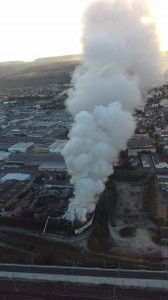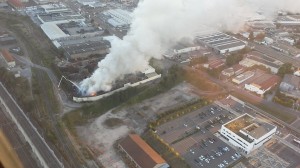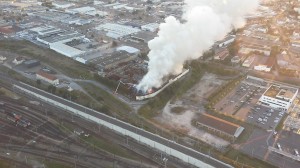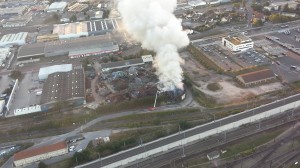On a Friday afternoon at around 1:40 p.m., in a metal waste sorting and processing facility, a fire broke out in a 1,000 m³ storage facility for large domestic appliances (excluding refrigerators and freezers). The personnel noticed smoke and alerted the emergency services. Firefighters were concerned that the flames would spread to other waste stored at the site. They protected the shredder by moving the waste out the way with 2 cranes. After assessing the situation, it was determined that 220 m³ of waste were involved. The black fumes released by the fire could be seen from afar, and the emergency services advised residents to close their windows and asked a neighbouring company to confine its employees indoors. After verification, the fumes did not present any particular risk, although traffic on the nearby rail line was stopped. The fire was extinguished at 7:00 p.m. The following morning, the fire brigade continued to spray down the stock of scrap metal, but the situation was considered under control. The site remained under surveillance throughout the weekend. Activity at the site and rail traffic resumed on the following Monday morning.
Consequences
A portion of the 5,000 m³ of extinguishing water used during the intervention seeped into the ground. Only 150 m³ were eventually recovered and evacuated to a treatment facility. As the site is located in the protection perimeter far from drinking water catchment areas, a press release, dated 06/09/2016, specified that analyses showed no impact on water quality at the catchment points.
Causal analysis and measures taken
The fire had started at the edge of the stockpile of large domestic appliances (excluding refrigerators and freezers). The facility operator mentioned 2 possible sources of the fire: spontaneous combustion of the waste, possibly due to the heat wave at the time of the disaster and the large stock of waste, or an act of malicious intent. The inspection authorities for classified facilities noted that the storage height, more than 15 m, had exceeded the height of the site’s perimeter fencing. The operator explained the large amount of stock on its premises was due to the fall in metal prices, the rail freight strike, the summer period and by the transport companies’ holiday periods. However, site saturation had remained a recurring problem, which had already been observed during previous visits by the inspection authorities. Despite repeated requests, the operator had not taken any effective action to remedy the situation. The saturation of the site resulted in a lack of a waste-free area needed to extinguish the fire.
Other non-conformities were also highlighted, in terms of:
- accessibility: the internal roadways were too narrow, preventing the operator’s cranes and the emergency equipment from intervening simultaneously;
- fire prevention and control measures: internal and public measures were insufficient and private fire hydrants had to be used;
- fencing: the inspection authorities for classified facilities found that the fire had damaged the site’s fencing (concrete wall, metal cladding and fence), and there was a risk that it would collapse. During their intervention, the firefighters feared that the entire structure would collapse.
Several fires had already been reported at the site, all of which had revealed similar non-conformities in terms of operating procedures and the management of emergency situations (ARIA 38109 on 21/04/2010, ARIA 40035 on 13/02/2011, ARIA 43091 on 26/11/2012, and ARIA 46819 on 06/07/2015).
A formal notice was issued, and the inspection authorities requested that the operator undertake the following actions:
- conduct a stability study of the fence and perform the necessary repair/reinforcement work;
- limit the storage height of waste to the height of the metal cladding;
- create the storage area in isolated areas to prevent domino effects;
- create an isolation area behind the storage facilities, so that the waste is not in direct contact with the cladding;
- create a buffer zone, permanently free of any waste whatsoever, for firefighting purposes as required;
- establish internal traffic lanes that are wide enough to allow fire engines to operate without difficulty;
- arrange the installations in such a way that any accidental pollution (fire-extinguishing water) is completely contained within the site.







